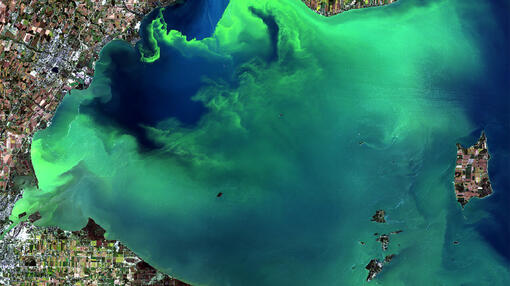types of water pollution (basics)
1. groundwater - once polluted, may be unusable for decades, or even thousands of years.
2. surface water - surface water is what fills our oceans, lakes, rivers, etc.
3. ocean water - Eighty percent of ocean pollution originates on land from spills, debris, and other contaminants

an image of excessive, toxic algae blooms
most common types of pollution
1. agricultural - top source of contamination. after rain, excess nutrients are washed into waters and causes algal blooms which can be harmful
2. sewage and wastewater
3. oil spills
4. radioactive substances - release of these substances threatens groundwater, surface water, and marine resources
after researching water pollution in each continent, i have found the following trends:
in 6/7 continents, the main sources of water pollution are agricultural runoff and industrial sites
in several continents, eutrophication is another pollutant-- eutrophication reduces oxygen levels in the waters which can lead to death for some organisms.
another common pollutant among the continents is littering. Food waste, chemicals, and other garbage are dumped into our oceans, which can lead to eutrophication.
for developing countries, they face financial constraints that makes it difficult to have sanitation systems and access to clean water daily. For example, 2/3 of sub-Saharan Africa rely on surface water, which is usually highly polluted.
in developed countries in continents such as North America and Europe, the main issue for water pollution is from industrialization whereas for developing countries, it is wealth.
how is it like in developing countries specifically?
In less developed countries, which are mostly found in Africa and Asia, sanitation and access to clean water can be difficult due to financial constraints.
In sub-Saharan Africa, several hours are spent each day searching for water. Instead of working or attending school, women and young girls are forced to carry and transport water.
Lack of sanitation and clean water leads to susceptibility to diseases such as cholera, and can lead to dehydration and malnutrition.


In Bangladesh, 80% of the water that is available is used for agriculture. The groundwater used by 90% of the population contains arsenic, which can cause cancer and is extremely dangerous to the body.
(see: "Environmentalists for BLM ♡" for more information regarding environmental racism)
Yemen, a country that could be wiped off the map
UNICEF has declared Yemen's situation as the largest humanitarian crisis, help here:
yemencrisis.carrd.co
In 2017, Yemen had a cholera outbreak due to airstrikes that damaged hospitals and the water supply. The government of Yemen halted funding for public health, leaving 14.5 million people without regular access to clean water, leading to the cholera outbreak.
~85,o00
children have died because of the famine
Yemen has ~200 cubic meters of water per person each year. A reasonable level is considered 1,000
Currently, in 2020, Yemen is still fighting cholera but is now also fighting against COVID-19, a famine, and a Civil War.
Due to the economic crisis, hospitals are poorly equipped and unable to properly treat for cholera and COVID-19.
Yemen is also facing floods, destroying homes, food supplies, and killing many.
